The first part of this article consists of the details of planning for my ultralight speedpacking trip in the White Mountains of New Hampshire. Scroll to the end to find out what happened.
Click here to purchase the Ketogenic Backpacking cookbook on Amazon
Going Fast, But Not Too Fast
Carbohydrate depletion impairs sprint speed and may impair peak aerobic capacity [1,2]. You need carbs to perform your best in repeated bouts of explosive movement, ie weightlifting, combat and field sports. But you don’t need carbs to do slower things like hike or bike at a moderate pace [3]. A ketogenic diet is the perfect way to maximize fat burning and lower pack weight on a bike tour or backpacking trip over moderate terrain. I hiked 707miles of the Appalachian Trail on a ketogenic diet carrying a pack full of food and gear for myself, my wife and my 11 week old daughter, and sometimes carrying her too. But what about hiking fast up mountains? Is speedpacking too fast for keto? Do you need carbs to bag peaks?
I decided to test the limits of the ketogenic diet on an aggressive speedpacking trip in the White Mountains of New Hampshire.
Crunching the Numbers
A study on elite cyclists found that a month of eating only 10% of calories from carbohydrates increased the amount of work that could be done from fat alone from their former range of 90-540kcal/hr up to 660-1000kcal/hr [3]. Weighing 180lb and carrying a 16lb pack, I would need to burn around 600 kcal/hr which was well within the range of the keto-adapted cyclists but above the range of the carb-eating cyclists [4]. I recently tested my respiratory exchange ratio at DEXAFIT Minneapolis and found I was burning 95% fat at rest [5]. Would I be able to burn fat at a high enough rate to fuel me up the steep climbs of the White Mountains of New Hampshire?
How Much to Eat?
My calculations predicted a whopping daily expenditure of 7906kcal; 6014kcal from hiking for 10 hours [4] plus my resting metabolic rate of 1892 from my recent test at DEXAFIT Minneapolis [5]. I decided to bring only 5,000kcal/day and burn body fat to fuel the rest for three reasons:
– Prolonged endurance exercise blunts my appetite
– Prolonged endurance exercise impairs my digestion
– My experiencce hiking the Appalachian Trail makes me suspicious that the caloric expenditure estimates above are too high. [6].
I knew from my latest DEXA scan from DEXAFIT Minneapolis that I was carrying 14lbs of unessential fat. The ketogenic diet would allow me to tap into this 42,000kcal of fat and burn it at a rapid rate. If I did burn 8,000kcal/day for 4 days and eat 5,000kca/day I would lose pound of fat a day. Why carry it in your pack when you already have it on your body?
Meal Plan
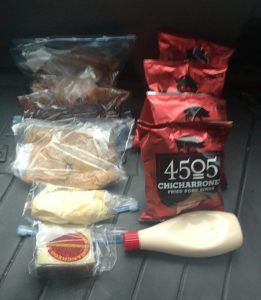 I decided to go stoveless to reduce weight and save time. In the heat of midsummer, hot food wasn’t missed.
I decided to go stoveless to reduce weight and save time. In the heat of midsummer, hot food wasn’t missed.
I planned to hike for four days and eat five meals a day, about 1,000kcal each. Breaking it up this way ensured I would have enough bile to absorb each meal.
I packed a total of 20,490kcal, weighing 106oz (6.6lbs) including packaging with an average kcal/oz of 194, a combined Wilder ratio of 4.4 and a total cost of $83.85. I could have cut costs with cheaper ingredients, but I opted for high quality fuel.
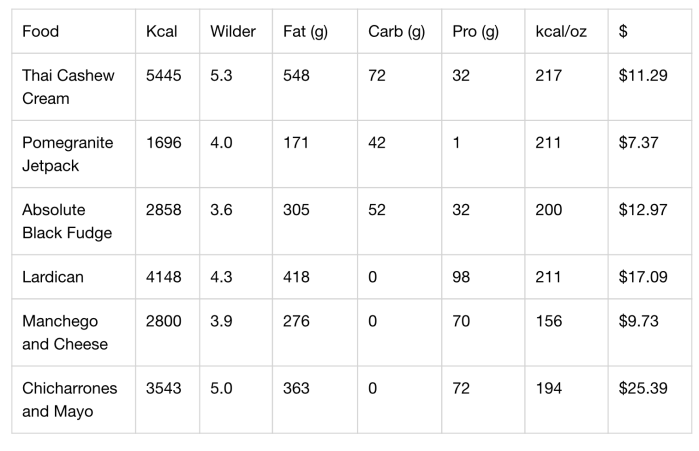
Gear
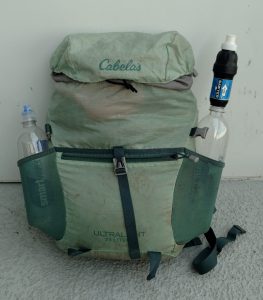 Instead of bringing a lot of ultralight gear, I followed the strategy of only bringing things I would absolutely need. I used the Clark hammock and rainfly I already had instead of buying a lighter shelter. I brought two battery packs to ensure I would be able to capture all my data on Strava. A pair of shorts for hiking, thermals for sleeping and no rain gear. If I am hiking fast I stay warm, if I bring the rain gear I just sweat in it.
Instead of bringing a lot of ultralight gear, I followed the strategy of only bringing things I would absolutely need. I used the Clark hammock and rainfly I already had instead of buying a lighter shelter. I brought two battery packs to ensure I would be able to capture all my data on Strava. A pair of shorts for hiking, thermals for sleeping and no rain gear. If I am hiking fast I stay warm, if I bring the rain gear I just sweat in it.
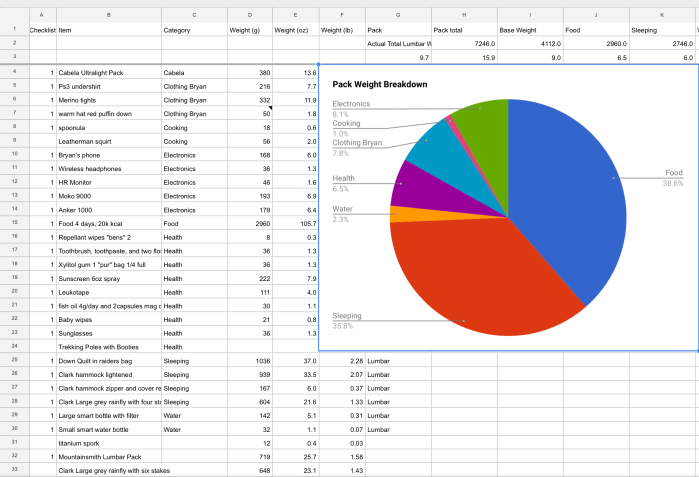
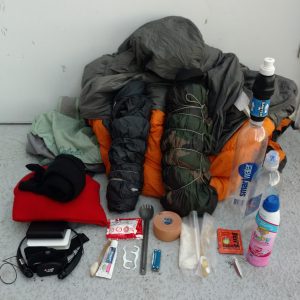 I anticipated that orthopedic problems would be my limiting factor so I planned to rely heavily on my trekking poles, tape key areas and take a high dose of fish oil.
I anticipated that orthopedic problems would be my limiting factor so I planned to rely heavily on my trekking poles, tape key areas and take a high dose of fish oil.
The Results.
Keto worked. I had tons of energy. I attacked slippery steep climbs, charged through ankle-deep mud in alpine bogs and raced from peak to peak for 12 hours straight. Strava recorded 51 miles, 16,913ft of elevation and 10,881kcal burned in two days. I ate about 3,000kcal each day and never got hungry leaving a deficit of about 8,665kcal, or 2.8lbs of fat burned in 2 days. My body burned its fat stores in a bonfire that fueled an epic adventure.
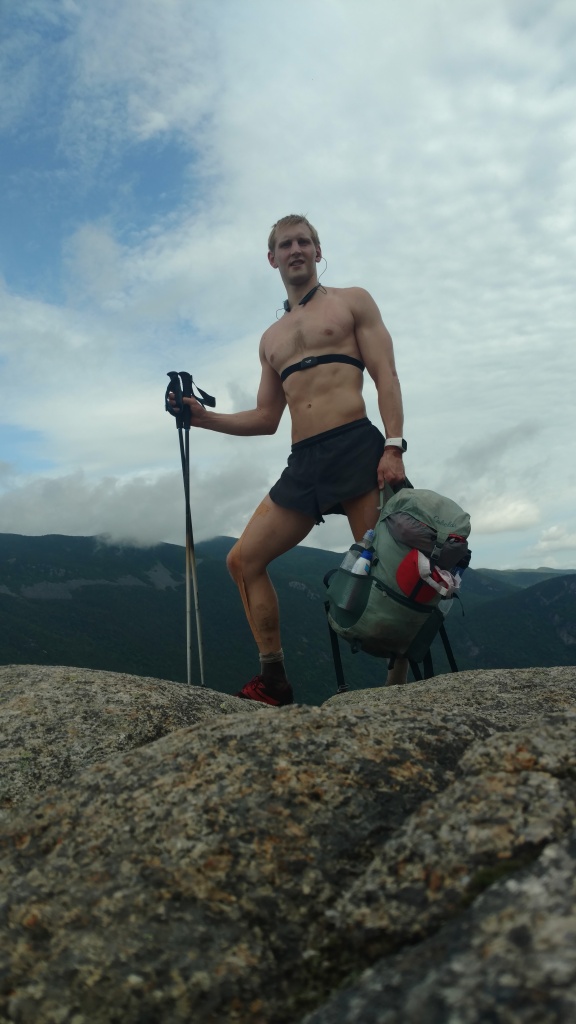 Trail Log
Trail Log
Day One
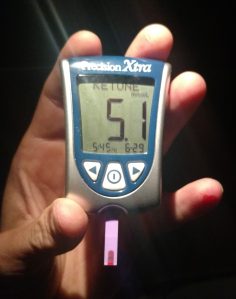
Breath in, two, three, four, breath out six, seven ,eight, nine ten. Orange barrels blurred by, walls of dark foliage leaned in and the first drops began to burst on the windshield. By the time I parked at the The Basin Trailhead and put away my Muse meditation headband, the roof was drumming with a steady rain. I hadn’t planned for this.
A dull tingling informed me that my right leg planned on waking up a little later than the rest of me. I pulled the reluctant leg back across the center console and strapped on my HR monitor to measure my heart rate variability (HRV). Three minutes later I was advised to take a rest day.
Despite 90 minutes of calm breathing on yesterday’s drive, my HRV was 70 and my HF was 506, numbers well below my norms in the mid 80s and 2,000s indicating my nervous system was stressed. This was the first day of my four day solo assault on the White Mountains. At least my metabolic system was in the right place, last night’s blood ketone levels were very high at 5.0mmol/L.
Two weeks prior I finished a 707 mile section hike on the Appalachian trail with my wife and 11 week old daughter. I had carried a 50-80lbs pack, depending on the amount of food and whether or not I was carrying the baby. Without the ketogenic diet my pack would have been heavier, or we would have had to resupply every few days, or worse lose some of the lean mass I had worked for years to accumulate. My feet had hurt but my energy had never flagged on the ketogenic diet and I wondered what I would be capable of with a lighter pack.
Now with a pack weighing 16lbs I felt like I was floating down the trail. I relished the feeling of walking without pain, washed in green, drawn into the mountains by a heady redolence of pine and moist earth. Then my wrist started to hurt. I taped it with a technique I learned at a Mulligan course years before. The pain went away. So far so good.
Like a playground bully, the trail dared me to climb up the slide… then poured water down it. I gained 2,500 feet of wet rock and mud in 2.5 miles, then sailed along the high ridge another 1,200 feet to Mt Lafayette, gaining the admiration of more than one summer camp hiking group and a growing ache around the kneecaps.
I ducked out of the wind and began taping my knees, better to stay ahead of this pain. I wasn’t hungry or thirsty but I thought it prudent to stay ahead of those things too. I crunched clouds of pork skin with stiff peaks of mayo and then floated down sheets of wet granite. More than once my feet flew down ahead of me. Each time I picked myself back up, grateful for no severe injury. The day rolled on, the trail passed under my feet, the trees returned, as did the rain. My knees were feeling better, but there was a new sensation in my Achilles.
Ambient temps were in the 50s and the water felt colder, but I waded into the Saco river for a pre-slumber ablution on the premise that after 27 miles and 8,736ft of elevation some cryotherapy was in order. After a seven minute feast of shredded beef in lard followed by chunks of peanut cocoa fudge and two magnesium tablets, I rocked off to sleep in my Clark Jungle Hammock as falling drops typed on my rainfly.
Day Two
And so my day of presidents began. On the stairs to Webster, Jackson, and Pierce, a wall of roots and wet rocks greeted me that blurred the definitions of hiking and rock climbing. After a few scoops of MCT rich blend I call Pomegranate Jetpack, I skated the slimy puncheons of an Alpine Bog, then discussed the weather with the hostess at Mizpah Spring Hut while savoring water I hadn’t had to filter.
On Eisenhower the weather turned.
At first it was a touch of rain, and a dimming of the lights. But steady curtains of moisture began to fall and it was real rain by the time I reached the Lake of the Clouds Hut. More pork clouds and mayo and a sobering check of the forecast. Severe thunderstorm warning for the rest of the afternoon. Mt Washington was 1.5miles away, then 7 miles of exposed trail above 5,000 feet before Madison and a descent. Even without the shortened stride of my stabbing Achilles, I would be exposed to lightning for several hours. Lightening rarely hits people. But when it does, it tends to hit young males, perhaps because they are the ones most likely to hike a ridge in a thunderstorm.
The rain let up. I made a dash for Mt Washington, it was only 1.5mi away and if the weather turned so could I. I climbed from slick rock to slick rock, landing flat footed with a short stride to avoid the sharp pain from my Achilles. My energy was high, bountiful really. The 20,000kcal in my backpack weighed only 6lbs, and I barely had any need to eat it. In a state of nutritional ketosis, my body was burning its own fat at such a high rate I could run up mountains.
At the top of Mt Washington I was greeted fog so dense I could only see the gift shop from 20 feet away and the uncanny feeling of sticking my head out the window on the highway. The big ones always seem to have a gift shop…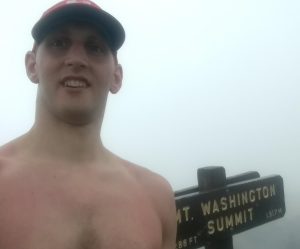
I let gravity take me down.
Using my poles to unload my taped knees and landing flat-footed to unload my Achilles I raced the storm down the mountain.
It caught me before Mizpah Springs Hut.
In the hut I removed my shoes to check my feet. I stared at open sores on the back of each knuckle and toes so white and waterlogged I couldn’t tell where the blisters began or ended. After a few spoonfuls of Thai cashew cream and a liter of water I checked the weather. For hours I was out in the wind and rain in only my shorts and the heat generated by hiking, now sitting here indoors and still soaked I was beginning to shiver. Tomorrow would be sunny. It was 4:30 and I had already covered 18miles, perhaps I could stay here tonight and do a big day tomorrow.
Was there any vacancy?
Yes, they had a room and warm shower.
I opened the door to check the weather and was met by a wall of water and a crack of thunder.
I’ll stay.
It’s $171.00 per night.
I’ll go.
Out into the storm I ran, screaming like a banshee, stomping in puddles and pumping my arms wildly. Relishing the fact that 75% of the energy of exercise is lost as heat. I needed every bit. I was soaked in adrenaline. The trees were not tall, but they were taller than me, which was enough. I sprinted through the clearings, pelted by hard bullets of rain. I went down more than once. Bleeding knuckles but no more. My pains receded and only the trail remained. The next place to put my foot was all that mattered. The trail got steeper and became a stream, then began a waterfall. Whitewater obscured my path. My pace slowed. I climbed down the ledges and grabbed the roots I had touched that morning. I began to shake. To go faster was to risk a fall and injury, to go slower was to risk a fall in body temperature. As the former would also lead to the later, I took my time and clenched my jaw against the cold.
I neared the Saco river and my Achilles reminded me of the abuse they had incurred thus far. I hoped my hasty packing had kept some of my warm gear dry.
It had not.
After 24 miles and 8, 177ft in 12hrs, I wrung out my soaked long underwear, hung my dripping hammock, pulled my damp down quilt over me. I listened to the beating of the rain on my shelter. I didn’t sleep much that night.
Day Three.
After shuffling around my site like a Parkinsonian to avoid the bite of my Achilles, I decided to end the trip early. My ketogenic backpacking menu had given me all the energy I needed and then some. I felt like I had a turbocharged engine in a beat-up old pickup. No amount of engine tuning could compensate for the fact that the suspension was kaput.
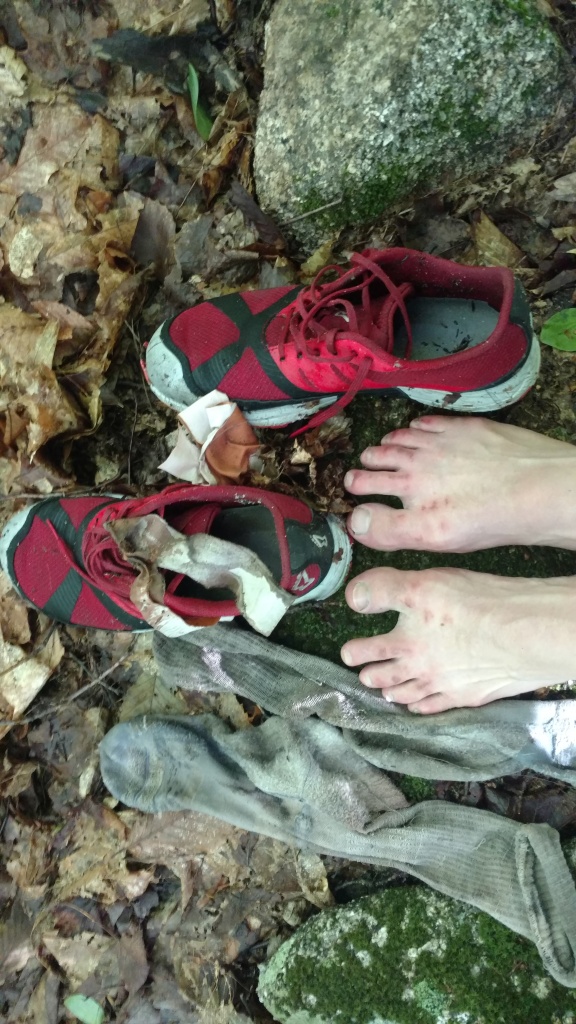
Bryan Ausinheiler PT, DPT, CSCS, OCS, FNS
References
- 1RM Bench press and squat gains were similar between ketogenic and standard American diets. Anaerobic sprint performance was impaired on the ketogenic diet. McCleary, Sean A., et al. “Effects of a ketogenic diet on strength and power.” Journal of the International Society of Sports Nutrition 11.1 (2014): P41.
- This study found no impairment in V02max using a diet of 45% of calories from protein, 55% from fat and 5% from carbohydrates. Langfort, J., et al. “Effect of low-carbohydrate-ketogenic diet on metabolic and hormonal responses to graded exercise in men.” Journal of physiology and pharmacology: an official journal of the Polish Physiological Society 47.2 (1996): 361-371.
- On a high fat diet, limited carbohydrate stores are conserved, fat metabolism is enhanced and endurance performance is unimpaired. Helge, Jørn Wulff. “Long-term fat diet adaptation effects on performance, training capacity, and fat utilization.” Medicine & Science in Sports & Exercise34.9 (2002): 1499-1504.
- “Backpacking” is a 7 MET activity. To calculate average energy expenditure per minute: multiple MET x 3.5 x body weight in kg and divide the answer by 200. Ainsworth BE, Haskell WL, Herrmann SD, Meckes N, Bassett Jr DR, Tudor-Locke C, Greer JL, Vezina J, Whitt-Glover MC, Leon AS. The Compendium of Physical Activities Tracking Guide. Healthy Lifestyles Research Center, College of Nursing & Health Innovation, Arizona State University. Retrieved May 11, 2015 from the World Wide Web. https://sites.google.com/site/compendiumofphysicalactivities/
- After four months on the ketogenic diet, and after a 20hr fast, my respiratory exchange ratio at rest was 0.72, indicating 95% of my metabolism was coming fat.
- I hiked the the Appalachian Trail for two months with a 50-80lb pack averaging 12 miles per day, reduced my food from 6,000kcal down to 5,000kcal per day because I wasn’t hungry, and in the end I gained 3.2lbs of fat. This suggests I was eating more than I needed.